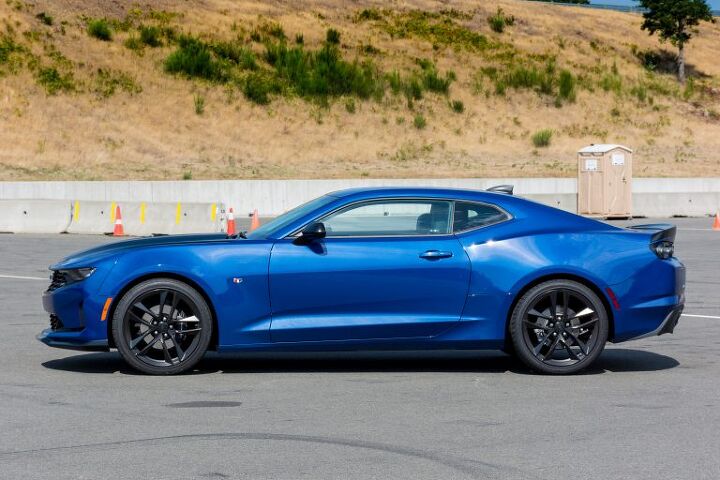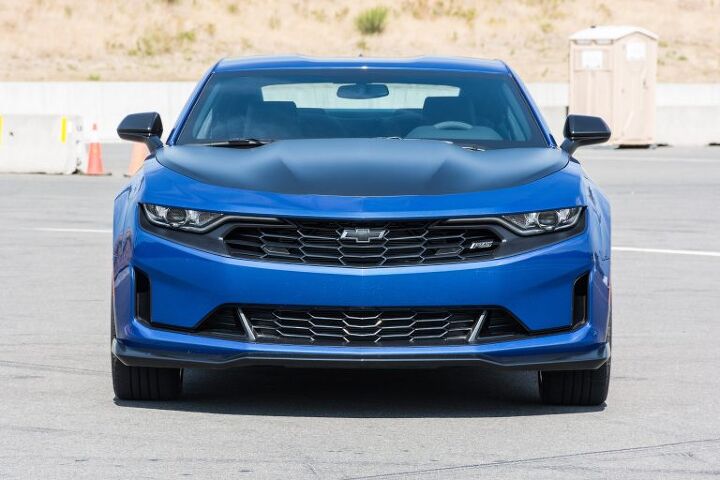2019 Chevrolet Camaro Turbo 1LE First Drive - The Perfect Track Rat

The word Camaro, depending on who you ask, is either French slang meaning “friend” or a Spanish word for shrimp. But GM PR reps, when the name was unveiled in 1966, had a carefully crafted definition for the inevitable question from gullible, likely gin-soaked journalists: “A Camaro is a small, vicious animal that eats Mustangs.”
That’s it right there — for over fifty years, the Camaro has been defined by the competition. But that competition is a bit different now, as there’s a good turbo four-cylinder available from Dearborn. Not content to target the usual opponents, the 2019 Chevrolet Camaro Turbo 1LE has both track-day glory and compact imports in its sights.
(Disclaimer: Chevrolet flew journalists to Seattle to sample the Camaro Turbo 1LE, as well as the Malibu RS I covered on Monday. Two nights in a hotel and food, of course. Chevrolet did give me a small SD card that recorded my on-track sessions for posterity.)
When Chevrolet debuted the sixth-generation Camaro in 2016, the surprise powertrain was definitely the 275 horsepower turbocharged four-cylinder. Prior, the only application of a four-pot was in the early third-generation model, when the rather awful Iron Duke made its thrashy appearance.
When pressed, Chevrolet spokespeople acknowledged that a generation of enthusiasts have generally eschewed the traditional big displacement cars in favor of compacts with smaller, high-revving four-cylinder engines — often with forced induction either from the factory or from a catalog. Turbocharging offers tuners plenty of headroom for more power with relatively simple, bolt-on changes.
In other words, Chevrolet is nodding and winking to encourage aftermarket firms to develop ECU tunes and intake and exhaust upgrades for the LTG engine in this 1LE Turbo. There are a few firms already offering various performance bits — I’ve seen quoted numbers of over 380 hp to the rear wheels.
Yeah, I know that the standard V8 in the Camaro SS is more powerful than that. Power isn’t the point of the Camaro Turbo 1LE — it’s all about balance. With a shorter, lighter engine, there is simply less mass atop the front wheels, making the driving experience that much sweeter. I haven’t seen exact figures, but Chevrolet suggests that the front/rear balance is “nearly 50/50.” I’ll let the hardcore track rats get it on cornerweighting scales, though.
The RPO (Regular Production Option in GM-speak) code 1LE is a bit legendary in Chevy road racing circles. Developed originally for the Canadian Player’s Challenge series for showroom stock cars in the late Eighties, the 1LE took a regular Camaro and tossed a bunch of little tweaks at it to optimize it for track performance. Bigger brakes, a lighter driveshaft, a different fifth gear ratio, and an upgraded fuel tank (to minimize fuel starvation on fast sweeping turns) all converged on an otherwise stripped third-generation V8 Camaro to make the car more competitive in hotly-contested racing series both in Canada and the U.S.
That the 1LE package has moved from the V8 and V6 powered cars to the “entry” turbo four means the benefits of a track-tuned car are available to more drivers. The big benefit: a warranty that expressly covers track use. Many manufacturers offer cars that are competent on a race track, but will often hassle owners when evidence of track use appears on a car that needs service — or outright deny coverage altogether. Chevrolet, on all 1LE models no matter the engine, specifically states that warranties will be honored on unmodified cars. That means that the stock Goodyears do need to be maintained. Buy a spare set if you’re all about driving and striving and hugging the turns.
TTAC staffers — especially my old friend Bark — love to joke about journalists writing about how a car handles “at the limit.” We know that, since they didn’t take their test cars to a race track, they can’t possibly know the car’s behavior at the limits of adhesion unless they seriously risked both their driving privileges and public safety on public roads.
Driving the Turbo 1LE on track is a great experience, as the incredible balance means mistakes are easily corrected. There’s enough power to bring the rear around if needed, but not so much that an errant throttle stab will send you sideways. Handling is neutral, and trailbraking will allow the rear wheels to rotate toward the apex. We ran off and on the track for about two hours — admittedly, only about five hot laps at a time, with a few minutes in the pits between sessions for the obsessive prep team to check the tire pressures — and engine temperatures never wavered on a 85F day.
That’s where this Camaro Turbo 1LE comes in. By providing a neutral, safe handling car, it allows anyone who has the urge to try performance driving to do so in a safe environment — with a greatly-reduced risk to the wallet due to that performance warranty. Drivers can indeed explore their own limits, rather than that of the car.
I especially enjoyed the factory-available performance data recorder, which adds an SD card slot to the dash near the drivers’ left knee. Pop a card in, press a couple of buttons on the center display, and the front cameras will record your track day hero exploits for easy uploading to YouTube.
I realized after the track session that my polarized Oakleys were blocking my view of the HUD — and thus, the shift light. I’d prefer an LED shift-light to supplement the HUD, as I’m almost always in polarized shades.
I’m totally enamored with the new blue shade on my test car. Named Riverside Blue after the now-defunct road course in Southern California, it has an incredibly familiar look on this body for any fan (like yours truly!) of the golden era of Trans-Am racing.
When I noted that the color resembled a metallic version of the deep blue finish found on Roger Penske’s Camaro racers of the late Sixties, John Mack, Design Manager for Chevrolet Performance, told me that one of the names considered was “Oconus Blue — Sunoco spelled backwards,” as the Pennsylvania oil company was the primary sponsor of those dominant Mark Donohue-piloted Z28s.
Whatever the inspiration, it’s a magnificent color, and the 1LE-exclusive matte-black vinyl wrap on the hood adds a bit more race-inspired aggressiveness to the look. Other 1LE-specific styling touches include flat-black mirrors, rear spoiler, and front splitter.
While the basic styling of the Camaro hasn’t really changed within the wheelbase, the front and rear have seen some dramatic changes. Up front, the central body-colored beam has lowered a bit, creating a bit more balance between the upper and lower grilles. When you look at the Camaro from the side, there appears to be a touch more rake to the front end. It’s a bit less retro.
Out back, the taillamps appear more traditional, aping the quad oblong lamps so often seen on the classic Camaro. The lenses themselves look clear with grey accents — Chevrolet refers to them as “neutral density” — with red LED lamps behind those lenses.
I’m not completely sold on the appearance of the RS badge on this 1LE car. Certainly, adding a 1LE badge would be a bit goofy, but RS has traditionally meant style without performance within Chevrolet — see the Malibu RS I looked at on Monday. This Turbo 1LE has performance, with minimal frippery beyond those badges.
The 1LE package consists of the FE3 suspension kit: bigger front and rear sway bars, tuned dampers, stiffer bushings, along with summer-only Goodyear Eagle F1 tires, Track Mode on the drive mode selector, short-throw shifter, and a cooling package for engine oil, transmission, and differential.
Surprisingly for a car so clearly meant for track duty, the Camaro Turbo 1LE was quite comfortable on our drive back into the city. The ride was firm but controlled — the big sway bars might contribute to loud thumps over speed bumps or potholes — but the magnetic shocks kept things reasonable for commuting. I can easily see daily driving this for much of the year.
Interestingly, the 1LE package is available on any trim level of the four-cylinder Camaro – whether you choose the relatively-stripped 1LT Camaro at $25,995, or the plush 3LT with leather seats for several thousand more, the 1LE track package runs another $4,500. The 2LT 1LE pictured here starts at $27,500 plus $995 freight — making this a $32,995 track bargain. The performance data recorder was installed in another Turbo 1LE I took on the track, and is a $1,300 option.
In this track-focused Camaro Turbo 1LE, I’m convinced that Chevrolet has built the more-powerful Toyota 86/Subaru BRZ we’ve been asking for.
[Images: © 2018 Chris Tonn/TTAC; Screenshot courtesy Chevrolet Performance Data Recorder and poor-driving author]

Some enthusiasts say they were born with gasoline in their veins. Chris Tonn, on the other hand, had rust flakes in his eyes nearly since birth. Living in salty Ohio and being hopelessly addicted to vintage British and Japanese steel will do that to you. His work has appeared in eBay Motors, Hagerty, The Truth About Cars, Reader's Digest, AutoGuide, Family Handyman, and Jalopnik. He is a member of the Midwest Automotive Media Association, and he's currently looking for the safety glasses he just set down somewhere.
More by Chris Tonn
Latest Car Reviews
Read moreLatest Product Reviews
Read moreRecent Comments
- Corey Lewis It's not competitive against others in the class, as my review discussed. https://www.thetruthaboutcars.com/cars/chevrolet/rental-review-the-2023-chevrolet-malibu-last-domestic-midsize-standing-44502760
- Turbo Is Black Magic My wife had one of these back in 06, did a ton of work to it… supercharger, full exhaust, full suspension.. it was a blast to drive even though it was still hilariously slow. Great for drive in nights, open the hatch fold the seats flat and just relax.Also this thing is a great example of how far we have come in crash safety even since just 2005… go look at these old crash tests now and I cringe at what a modern electric tank would do to this thing.
- MaintenanceCosts Whenever the topic of the xB comes up…Me: "The style is fun. The combination of the box shape and the aggressive detailing is very JDM."Wife: "Those are ghetto."Me: "They're smaller than a Corolla outside and have the space of a RAV4 inside."Wife: "Those are ghetto."Me: "They're kind of fun to drive with a stick."Wife: "Those are ghetto."It's one of a few cars (including its fellow box, the Ford Flex) on which we will just never see eye to eye.
- Oberkanone The alternative is a more expensive SUV. Yes, it will be missed.
- Ajla I did like this one.










































Comments
Join the conversation
“ the magnetic shocks kept things reasonable for commuting.” MSRC is only included with 1LE package SS Camaros. You cannot get it on the I4T or V6 Camaros. Thus the reviewer wrongly believed that the ride was altered with changes in driving mode. This sure doesn’t instill confidence in his other observations.
“ the magnetic shocks kept things reasonable for commuting.” MSRC is only included with 1LE package SS Camaros. You cannot get it on the I4T or V6 Camaros. Thus the reviewer wrongly believed that the ride was altered with changes in driving mode. This sure doesn’t instill confidence in his other observations.